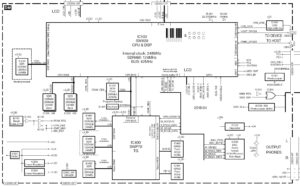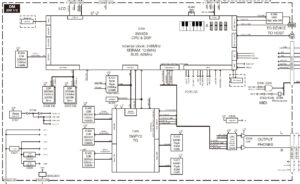Lately, I’ve been contemplating the future of the Yamaha Stage keyboard line: the YC organ and CP digital piano. Both keyboard lines are mature; the CPs were released in January 2019 and the YCs were launched a year later in January 2020. Both models have received updates (including new voices). The latest updates, however, feel like “life extension” updates while new models are in the latter stages of development.
Does it make sense to merge the two product lines and reduce the number of SKUs? That would be a bit of challenge for Yamaha as organ-focus and piano-focus are defining features for the YC and CP, repsectively. In terms of sound, the updates have brought both lines closer together even though the front panels and user interface remain distinct. The YC got a lot of additional AP and EP voices bringing it into CP territory.
Then there is the “CK effect.” The CK is an all-rounder with drawbars, CP-like front panel controls and a set of secondary sounds which, frankly, leave both YC and CP wanting. So, given CK, it should be possible to merge the two stage keyboard product lines. Right?
These thoughts prompted me to take a look under the hood of both YC and CP. Gigantic, purpose-built front panels aside, YC and CP are brother and sister as far as digital electronics are concerned. There are a few differences on the analog side such as CP’s balanced XLR outputs. Of course, the keybeds are different, too, in keeping with organ-, EP- and AP-focus.
Let’s tour stage CP first. The primary digital components are:
- Yamaha SWX09 CPU and DSP (248MHz internal clock)
- Yamaha SWP70 tone generator (191.9232MHz internal clock)
The SWX09 integrates an ARM Cortex host processor, an unspecified DSP core, and a raft of external interfaces. SWX09 also contains an AWM2-compatible tone generator and effects/mixing section. In stage CP, the wave ROM, wave RAM and DSP RAM interfaces are unused. Board real estate is wired for DSP SDRAM; the board position is unpopulated.
Without SWX DSP RAM, the CP models cannot implement Virtual Resonance Modeling (VRM).
The SWX09 is a mainstay in the Yamaha CLP digital piano line. The SWX09 is the primary workhorse component in the CLP-685 and P-515 digital pianos, for example. The P-515 and CLP-685 each have 256MBytes of wave ROM which should give us a rough idea of the size of the CFX and Bösendorfer waveforms (samples). [The CLP and P-515 EPs are relatively old and probably aren’t very big in comparison.]
We see the SWP70 tone generator throughout Yamaha’s many product lines, so it’s not surprising to see it in the stage CP, too. The CP has 2GBytes of NAND flash waveform memory. Its SWP70 has DSP RAM and wave RAM. DSP RAM supports effect processing and Wave RAM caches in-flight (most recently used) waveform samples. The SWP70 has its own unpopulated DSP RAM position, labelled “For future model”.
Not to leave anyone in suspense, the future model is YC. The YC SWX09 gets DSP SDRAM and the SWP70 gets its second DSP RAM channel filled. The CP is mainly a sample-playback engine while YC implements a Virtual Circuit Modeling organ engine in addition to sample-playback. I’m guessing that the SWX09 DSP hosts the all-important rotary speaker effect.
The YC’s waveform memory is the same capacity as CP: 2GBytes total waveform NAND flash. 2GBytes may seem gargantuan versus P-515’s 256MBytes. Pianos are memory hogs and with all of the updates, those 2GByte waveform memories may be full up (or close to capacity).
It will be interesting to see where Yamaha takes the Mark II stage keyboards. Here’s a few thoughts.
The CK61/CK88 gave Yamaha valuable experience with integration of organ, piano and other sampled voices. They have a lot of available content (voices, waveforms) and software IP (organ and rotary speaker simulation, AWM2, FM, VRM). If they combine their experience with existing technology, they could issue three models:
- 61 Semi-weighted waterfall keys (organ focus)
- 73 BHS weighted keys (EP focus)
- 88 GEX piano-action keys (AP focus)
Unifying the YC and CP designs into one reduces the number of separate SKUs from five to three and increases economy through scale.
There’s a lot of competitive pressure to produce an all-in-one stage keyboard. Nord (Clavia) have not been sitting on their hands and the Nord Stage (4) marches on! Yamaha’s own Montage M series shows the way, packing all-rounder functionality into a single keyboard.
As to new technology, announcements for the CLP-800 series Clavinova pianos are touting “a new tone generator chip with increased computational power” and imply that the new TG chip enables enhanced Virtual Resonance Modeling. An SWX10, perhaps? I’d like to see both VRM and VCM organ technology in the same package.
Physical
Keyboard Waveform Mem Expansion mem
--------- ------------ -------------
CLP-685 256 MBytes
P-515 256 MBytes
PSR-SX900 2 GBytes 1 GByte
PSR-SX700 1 GByte 400 MBytes
DGX-670 512 MBytes
CSP-170 1 GByte
Copyright © 2024 Paul J. Drongowski



Pingback: Floobydust: September 2024 - Sand, software and sound
Pingback: More NAMM 2025 products and speculation - Sand, software and sound